Thomas Patrick Higgins (1844-1920) was born on a farm outside
Boyle, County Roscommon, Ireland, the year before the onset of an Gorta Mor ("the Great Famine"). County Roscommon suffered terribly during those years. As a result of an Gorta Mor, Ireland lost one quarter of its population to death and immigration, changing it forever.
(Coincidentally, actor Maureen O'Sullivan,1911-1998, was also from Boyle)
During the last year of the American Civil War, not able to afford an education and with few local opportunities, Higgins emigrated to Troy, New York, joining an older, married sister there. A robust young man, he found work in Troy at the iron mines, then as a lumberjack in Wisconsin. Next he labored building docks in Chicago, levees in Louisiana, on the railroads and as a miner in Washington and Oregon. All hard, dirty, low-paid work. Higgins then fetched up in Bisbee, Arizona where he staked a copper claim in 1877. Lacking the money to buy the mechanized equipment needed for copper mining, he dug the ore by hand. The work was still hard and dirty and he was barely making a living, but at least he was working for himself. Finally, in 1900, after he'd proven the worth of his claim, a mining company bought him out.
Quickly switching gears, Higgins, now 56 years old, moved to Los Angeles. After 36 years of toil, Higgins had just 20 years left, and part of that would be lost to his final illness. But first thing, after arriving in LA, Higgins bought a 1890 frame home at 1153 Magnolia in middle-class Pico Heights.
The pretty house still stands on the corner of W 12th St and Magnolia:
 gsv
gsv
Higgins had
Albert C. Martin, Sr (1879-1960) add so much space to the home (in increments), to accommodate extended-family members, that it was turned into a hotel after Higgins died, then a sanitarium and is now apartments.
The home continually got wider and bulkier (Martin kept it looking good though). Even the carriage house was expanded and a third small building put in. Here's the signature line on a May 1912 building permit to add yet another "room, bath, closet" to the second floor. A Higgins relative was the contractor on that occasion:
 ladbs
ladbs
As one can see from above, the Higgins house grew like Topsy:
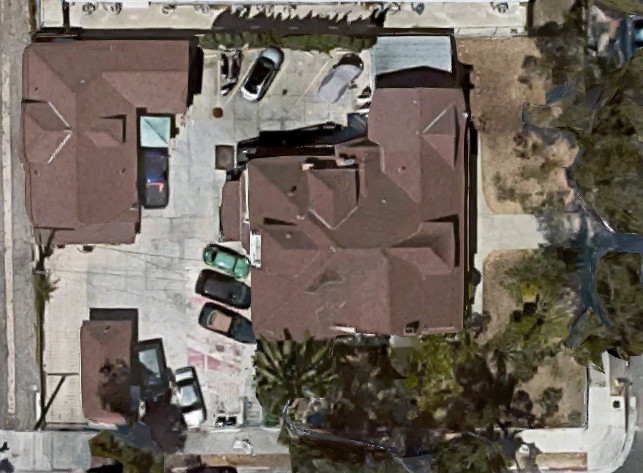 google maps
google maps
A.C. Martin, Sr, even after he had designed many large commercial buildings, continued to take
residential commissions
Higgins' great interests were the Roman Catholic Church, including Catholic education, and his extended family (he never married). With the money he received for his copper claim he supported
St Thomas the Apostle RC Church. (The parish was founded in 1903. Their building, by Maginnis, Walsh and Sullivan, at 1321 S Mariposa, just a mile from Higgins' home, was dedicated in 1905.) Higgins was very generous with his many family members who followed him to California. He gave out scholarships to young people who, like himself, could not afford an education and paid for the land for the new location of
St Vincent's College on Venice Blvd (now the site of Loyola High School), also a mile from his home. He supported the Boyle Heights Orphans Home as well, perhaps in memory of the suffering he'd seen as a child, back in his hometown of Boyle.
Higgins invested downtown too, in a hotel and later the Higgins office building, just a little over a block from each other. First was the Bisbee Inn on W 3rd, three doors east of Main in 1903 (because of street widening and realignment, it's now, sort of, the corner building). A remnant of Werdin Alley, which once dead-ended on the south side of St Vibiana's, borders the east side of the Bisbee. The name was soon changed to "Hotel Manhattan", "Bisbee" not having a lot of cachet in Los Angeles. Called "Girard's House" by 1910, since 1912 it's been known as the St George Hotel.
Arthur L. Haley was the architect. Grandson, son and brother of architects, Haley was born in Malone, New York in 1865, arriving in Los Angeles in 1890. Haley designed the Bisbee the same year he built the
Powers residence on Alvarado Terrace. Haley took both residential and commercial commissions. (He is probably best known today for the 1914
Lanterman House), a lovely craftsman home rendered in reinforced concrete.
The Bisbee Inn when new. It opened in 1905. The cornice no longer exists, nor do the balconies, but the rippling grid of fifteen east-facing bay windows, overlooking Werdin Alley, remains intact:
Quote:
Originally Posted by Flyingwedge

|
A 1909 birdseye map of the Bisbee, now named the "Hotel Manhattan". The land across Main St from St Vibiana's has not yet been cleared for the Higgins Building:
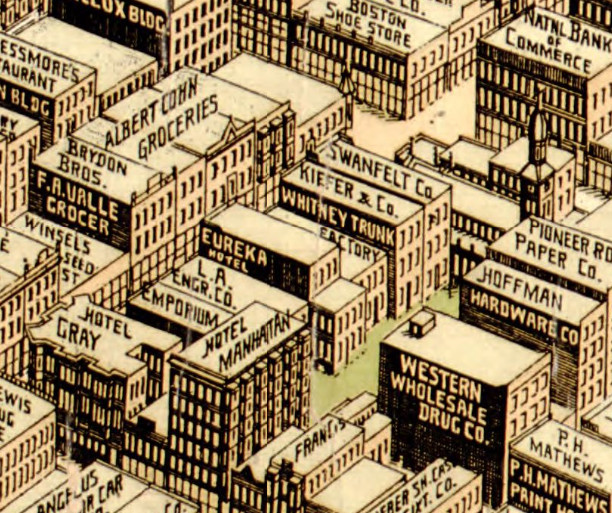 historicmapworks
historicmapworks
The 1910 Baist Map shows the Higgins in place and the Bisbee/Manhattan renamed "Girard's House":
 baist, 1910, plate 2
baist, 1910, plate 2
The Bisbee Inn today, known since 1912 as the St George Hotel:
Quote:
Originally Posted by ethereal_reality


saturnine
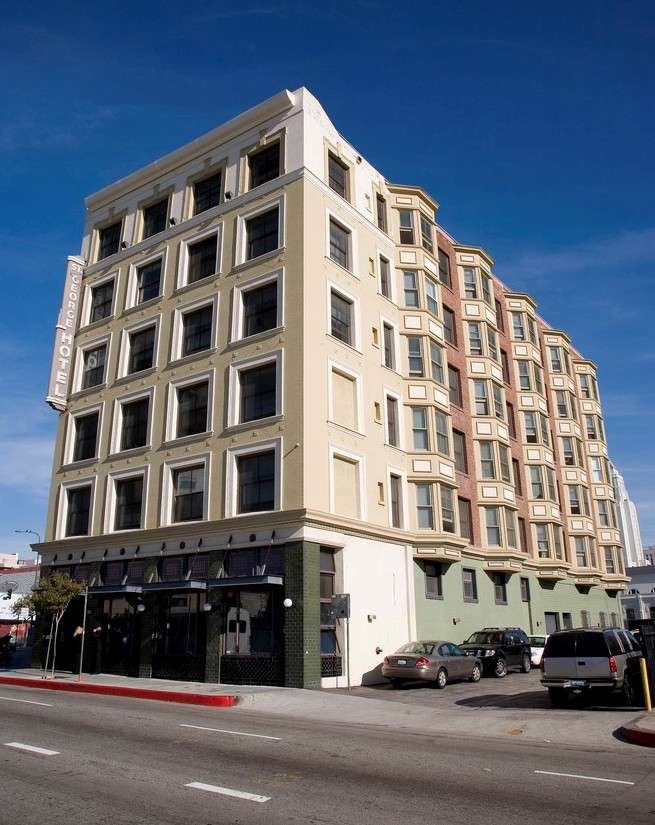
Gabor Ekecs |
The St George has a terrible history of fires. Conflagrations in 1912, 1952 and 1983 have killed 14 and injured scores.
Flyingwedge tells the tale
here. After the 1912 fire, Higgins turned to A.C. Martin, Sr to supervise the needed partial demo and repair. The name change to "St George Hotel" was made when the work was completed.
The St George fell to a very low estate before being rehabbed recently for low-cost housing. It's had its share of
noir, as
this example illustrates
Haley and Higgins must have hit it off, because, also in 1903, Higgins asked Haley to design a large office building for the SW corner of W 2nd and Main, directly across from
St Vibiana's (Ezra F Kysor & WJ Matthews, 1876). People encouraged Higgins to build on more fashionable Spring St, but Higgins believed in Main and hoped to make a suitable home for the Chancery Office of the Roman Catholic Archdiocese with a splendid view overlooking the facade of the cathedral. He was determined to accomplish this and spent $200K to acquire the two relatively new buildings that would have to be cleared.
St Vibiana's facing the future site of the Higgins Building across Main St ca 1887:
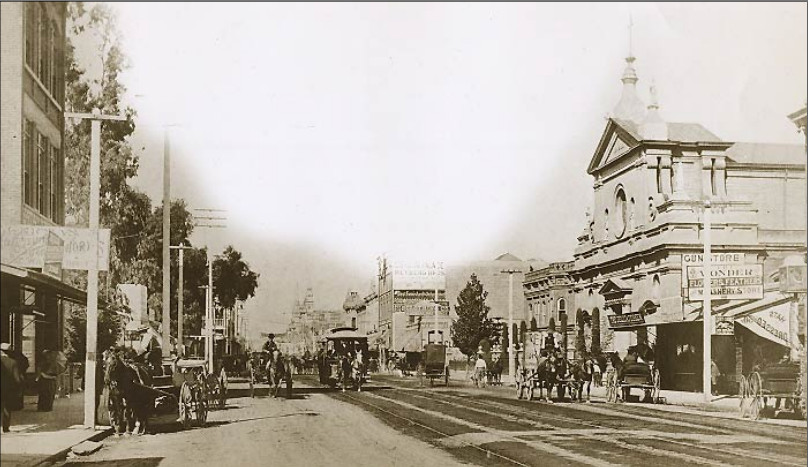 csulb
csulb
Architect/engineer Albert C. Martin, Sr joined the project as structural engineer. Both Haley and Martin favored reinforced concrete construction for strength and its fireproof qualities. However, the city didn't quite trust it. Finally, fire codes were changed and LA's first reinforced concrete building (the Homer Laughlin Annex/Grand Central Market) went up in 1905. The Hotel Hayward (6th and Spring) went in in 1906 and the annex to Hamburger's Department Store (8th and Hill) was in place by 1908. Finally, in 1909, as the site for the Higgins building was cleared and ground was broken, the Hotel Baltimore was rising at 5th and Los Angeles St and the Consolidated Realty Building at 6th and Hill, all of these were of reinforced concrete. But the city still balked at this construction method. During construction, and after agitation from Haley and Martin (who had organized his own architectural/engineering firm in 1906), the height limit for a reinforced concrete building was raised from 120 feet to 133 feet to allow the Higgins to be built to ten stories instead of eight, but that was still 17 feet shorter than similar steel structures were allowed to rise. Higgins, no stranger to construction, enthusiastically backed his architect's and engineer's ideas.
Arthur L. Haley told the L.A. Times in April of 1910,
“I have nothing to say against steel, but I object to the senseless discrimination against concrete. The builder in steel pays a tribute to the steel trust and neglects a home product."
The Higgins was a handsome, innovative, proto-modernist building in a Beaux-Arts skin. Martin and Haley really turned the page with this one. Except for heating, the Higgins was all electric (the city's first private power-generating plant was in the subbasement). City water was re-filtered for tenants' health and enjoyment. An effective system of shafts and vents ensured constant fresh air in every office. Elegant materials and finishes were used throughout and masses and masses of glass. And, of course, structurally it was more than sound. It was built to be "absolutely fireproof and earthquake proof" and has remained so. Beautiful retail space lined the Main and 2nd St street frontages. The Higgins, along with Haley's Powers residence and Lanterman House, is listed.
The Proposal. A line of trim memorializes the change from eight to ten floors (a hard-won victory):
 condopedia
condopedia
The Higgins going up as the ninth floor breaks the barrier (this view is looking west on 2nd St).
Note the paint store on the left. It's an unusual view of the one (Scriver & Quinn) which took over St. Vibiana's then-school building:
 uscdl
uscdl
The Higgins (at center). Child's Opera House is on the left (with flag). The Natick Hotel is on the right at 1st and Main:
 csulb
csulb
Another postcard view, showing only eight floors. (The publisher must have been very eager to get
any image of the not-yet-finished Higgins in the shops.):
 csulb
csulb
A.C. Martin, Sr was so pleased with the result that he moved in and stayed for 35 years (until his retirement). Martin's two sons took over management of the firm after WWII. Two grandsons run the firm now out of the A.C. Martin Associates-designed 444 S Flower St building (originally built as Wells Fargo's HQ in 1981, it replaced the Sunkist Building and its parking lot) . The Higgins Building made Martin's career. The construction innovations he developed then are still cited.
Other tenants at the Higgins were the Chancery Office of the Archdiocese (of course, that was the whole point), Clarence Darrow (while defending the McNamaras) and the Women's Progressive League.
Progressives were very successful in the West and rated a distinctive address. This 1915 Puck drawing by Hy Mayer shows the Movement inspiring women in the rest of the country:
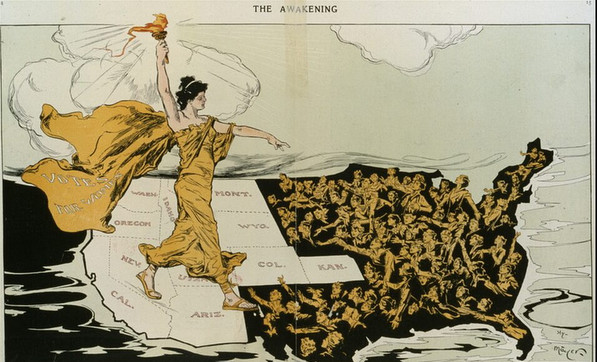 wiki
wiki
n.d., but pre-1925 (no Arrow Theater). Levy's Cafe is just left of center:
 csulb
csulb
General Petroleum (Mobil Oil) was an early tenant. They started with a single office, No. 402, but by 1934 were renting six of the ten floors, giving them signage rights at the top of the building. This view is from 1939 when Main St was beginning its years as the home of honky-tonks, dive-bars and discount stores:
Quote:
Originally Posted by Fab Fifties Fan


photo credit Blog Los Angeles |
Also in 1939 the Higgins was sporting a neon blade sign on the W 2nd St side. W 2nd was much more genteel that Main St:
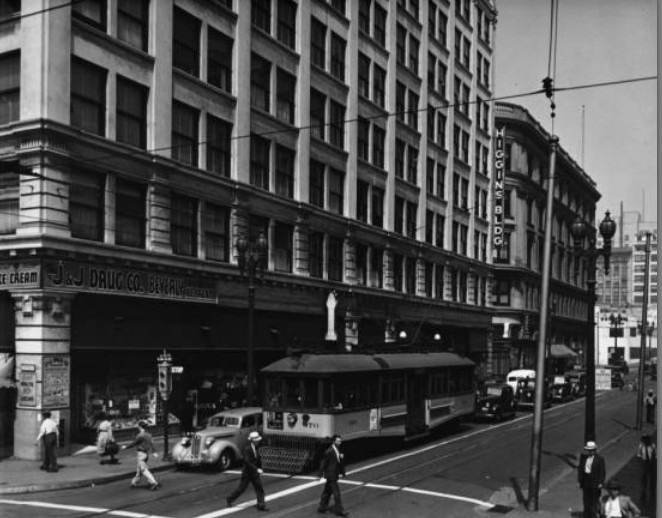 uscdl/dickwittington
uscdl/dickwittington
The back of the Bisbee/St George (just above center), St Vibiana's and the Higgins Building (ca 1934)
 first posted by NoirCityDame on pg 1501 (detail)
first posted by NoirCityDame on pg 1501 (detail)
1941. Awnings and some of our better-known chain stores:
 lapl
lapl
By 1949 General Petroleum/Mobil, pressed for space, decamped to their new, reinforced-concrete, Welton-Beckett-designed office building, then the largest in the West, at 6th and Flower (now the Pegasus Lofts).
Thirty years after Thomas Higgins' death, the Los Angeles County Department of Engineering bought the 40-year-old Higgins Building for one million dollars. The department was cognizant and proud of the fact that the Higgins was one of the strongest buildings in the county. But, 27 years later, in 1977, after a reorganization of county departments, Engineering left (after several moves, they are now in Alhambra).
Engineering memorialized themselves with a new threshold at the Higgins. It has been retained:
 dtlalofts
dtlalofts
Now aging and careworn, the Higgins was sold at auction in 1977 for $275K. Both the building and the neighborhood were derelict. (In 1996, to add insult to injury, the Archdiocese attempted to illegally destroy
St Vibiana's. A wrecking crew knocked the lantern off the tower before they were stopped.) The Higgins stood empty for almost 22 years, doors welded shut, until 1998, when it was resold and restored for residences, reopening in 2003. It now looks much as it did when it opened in 1910.
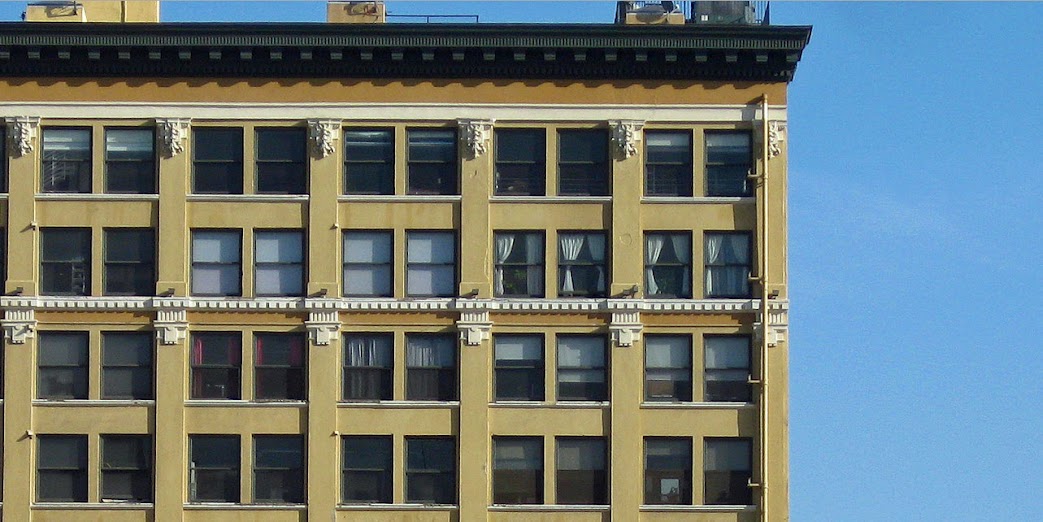 wildbell
wildbell
Day:
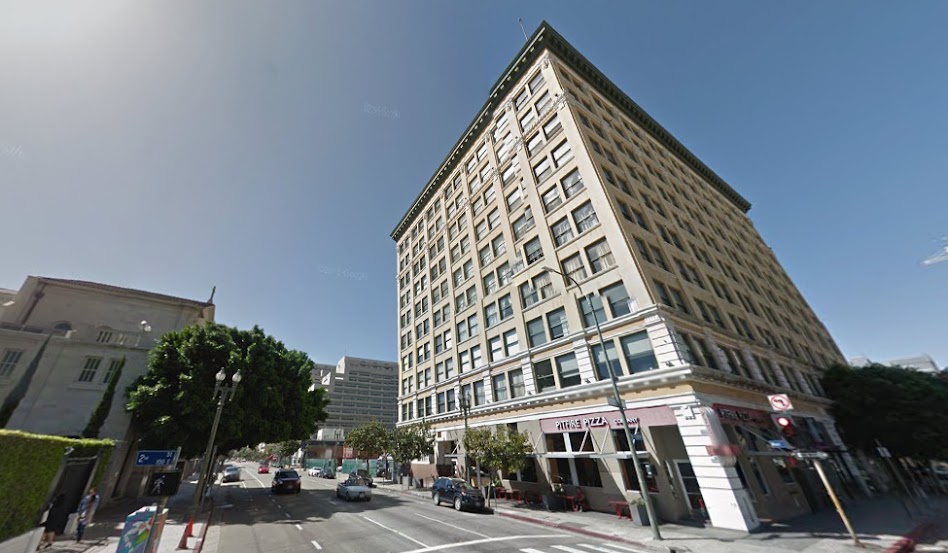 gsv
gsv
Night:
 liliya
liliya
Circa first half of 2007 (this was taken shortly before Vibiana's lantern was
restored in August). The construction pit for new Parker Center is in the foreground:
 toplacondos
toplacondos
The interior lightwell:
 dtlalofts
dtlalofts
The south wall from Harlem Place (once known as Center Place):
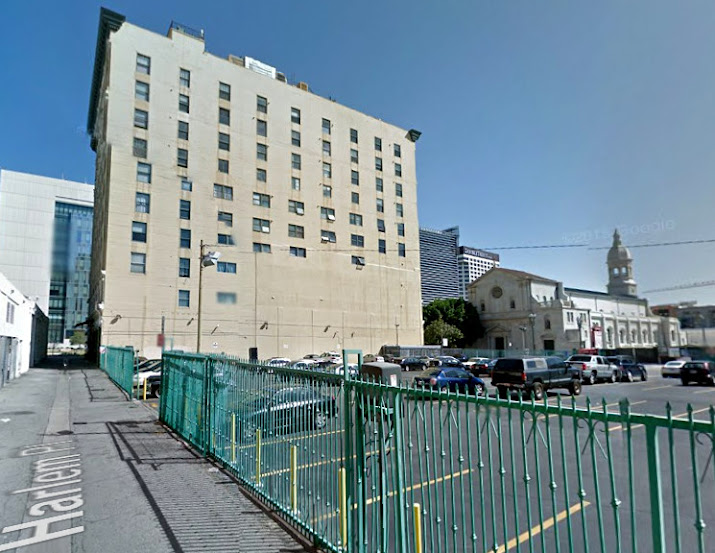 gsv
gsv
Outside, looking in, from W 2nd St
 mls
mls
Inside, looking out:
 mls
mls
The stairs:
 mls
mls
The elevator bank:
 mls
mls
One of the penthouse spaces:
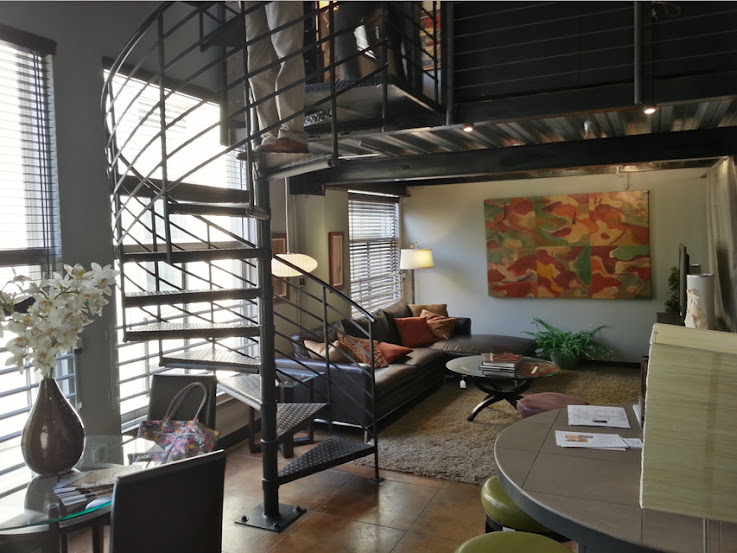 https://loftla.files.wordpress.com/2013/03/20140125_125547_hdr.jpg"]loftla
https://loftla.files.wordpress.com/2013/03/20140125_125547_hdr.jpg"]loftla
2nd-floor space with interior courtyard terrace:
 dtlalofts
dtlalofts
The Higgins with
Vibiana (now a venue):
 vibiana.com
vibiana.com
More info on the Higgins:
The
application for Historic-Cultural Monument status
Wiki
NavigateLA
Cecilia Ramussen in LAT
Condopedia